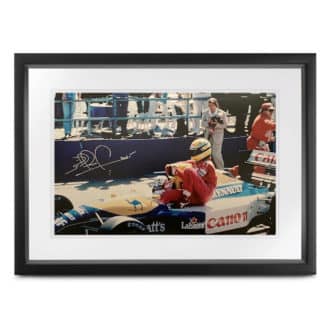
1985 European Grand Prix report: Hero time
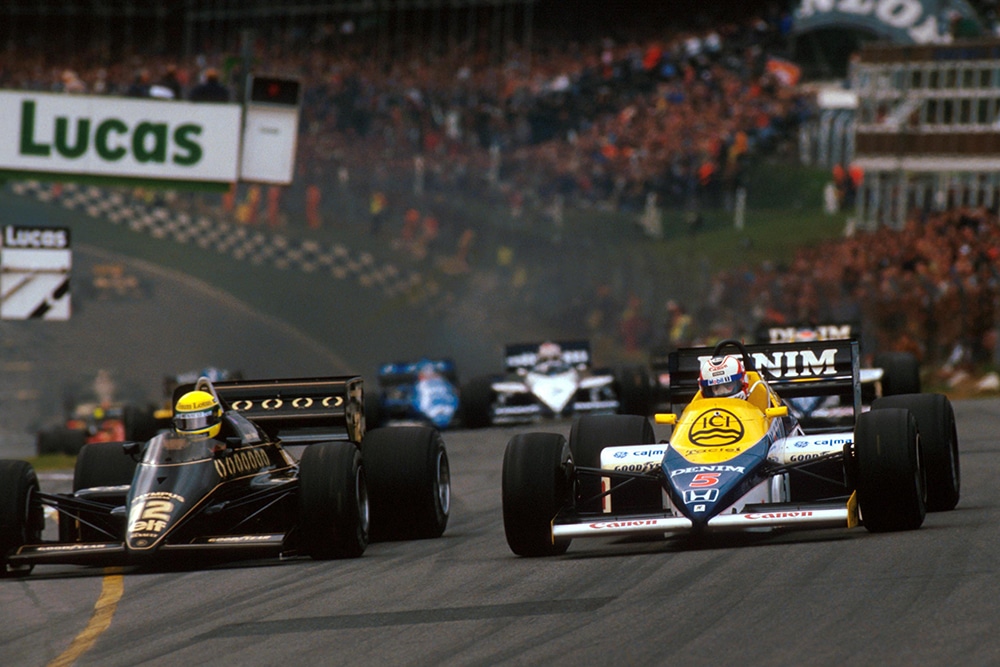
Nigel Mansell challenges pole-sitter Ayrton Senna on his way to victory
Motorsport Images
Brands Hatch, October 6th
One thing that the British sporting world is not short of is the ability to step in and take advantage of a “situation”. It was just that which gave us the opportunity of two Formula One races in one season in 1983; and it happened again this year. When the 1985 calendar was drawn up, the mythical New York GP was entered in the list and the European GP was scheduled to take place in Rome, even though neither city had a circuit! The idea of a street race in Rome was about as likely as the race in New York, and it was no surprise when both mythical events were withdrawn. Never one to miss a chance, John Webb and his Brands Hatch associates moved smartly in and collared the European GP for their Kentish circuit, as the British GP had been held at Silverstone this year. To organise a major event at short notice would have deterred most people, but not the Brands Hatch management, though their powers were sorely tried when FISA/FOCA changed the date twice, before settling for October 6th. That it was a rip-roaring success says all there is to say for Mr Webb and his workers.
Apart from being able to put on a big show at a moment’s notice, Brands Hatch is also readily available for pre-race testing, so by the time official practice started on Friday October 4th any worthwhile team had pounded round the Grand Prix circuit, and learnt most of what it needed to know. There were a few minor changes in the scene as the teams assembled in the-pits, notably the absence of Niki Lauda who was still nursing the wrist he damaged in practice at Francorchamps three weeks before. His place was being taken by John Watson, though logically it was difficult to see why, unless someone in McLaren or its sponsors Marlboro, was suffering an uncharacteristic touch of “conscience” over Wattie’s dismissal at the end of 1983, and was trying to make amends. Although Ken Tyrrell was down to only two Renault-powered 014 cars, due to Brundle crashing 014/1 in testing, he took a chance and nominated the Italian Ivan Capelli for his second car, Ken having been impressed with his form in the recent Donington F3000 race. Jonathan Palmer was still on crutches so Christian Danner was deputising for him once again in the Zakspeed, and the Beatrice-sponsored team reappeared with Alan Jones and its two cars, called Lolas because of Carl Haas’ long association with the Huntingdon-based marque.
On the mechanical front the two Williams-Honda cars driven by Rosberg and Mansell had been uprated to B-spec with new wishbone and pull-rod rear suspension replacing the rocker-arm layout, and this also entailed a new gearbox casing. The T-car was to the old specification. Brabham produced a brand new car for Piquet (BT54/9) and Ferrari produced a brand new car for Johansson (156/85-086). There were two signs of confirmation that the Regie Renault was disbanding its team at the end of the year, one that John Gentry was no longer looking after Warwick’s car, and had joined Brabham, and the other that Tambay announced that he had joined the Carl Haas Beatrice-Ford team for next year. Derek Warwick has not finalised his 1986 plans, but had done a lot of test-driving for Lotus before this event, and he will be a very silly boy if he does not accept an offer to play a very strong number two to Ayrton Senna if such a proposition eventually comes his way.
Qualifying
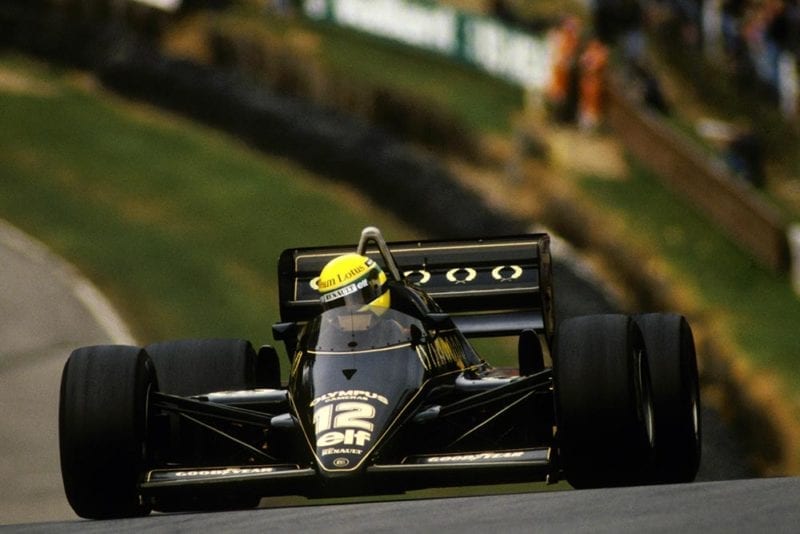
Ayrton Senna took his sixth pole of the season for Lotus
Motorsport Images
All this season the strides forward in engine power from BMW, Ferrari, Porsche, Honda and Renault have been spectacular and the control of that power has enabled lap records to be shattered at every appearance. The chassis designers have been panting to keep up and even the tyre firms have had their work cut out to handle the horsepower. Consequently it was no surprise when all previous fast laps at Brands Hatch were put in the shade once the serious business got under way. Similar to all season we have become used to a black and gold Lotus setting the pace, driven by Ayrton Senna in his first season with the team, and both days of practice saw no change in this pattern.
Previously the natural pace-setter was Nelson Piquet and his Brabham, but the switch to Pirelli tyres held him off the pace for quite a while, but as the season progressed the Italian tyre firm made serious strides forward and once Piquet had the tyres to match those of the Goodyears on the Lotus he was up at the front once again, and the qualifying sessions for the European Grand Prix saw a battle royal between the two Brazilian drivers, Senna coming out on top by three-tenths of a second, with a time of 1 min 07.169 sec, an average speed of 140.1 mph, and we thought the old fastest lap of 132 mph was spectacular. The incredible thing is that there is no real straight at Brands Hatch, nor any really flat surface, the circuit undulating up and down all the way round, and the bit down Pilgrims Drop looks straight, but at Formula One speeds by the time you have gathered it up out of the climbing left-hander out of the Stadium, you have to start aiming across to the other side of the road ready for Hawthorn Bend.
While the lap times and speeds were pretty shattering, it was the maximum speeds recorded through the Longines speed-traps that took the breath away. There was a light-beam speed-trap on the finishing line that gave Mansell the highest speed with 191.4 mph and Rosberg in second place with 190.2 mph, and another one at the cut-off point for Hawthorn Bend on the back of the circuit that gave Mansell fastest at 196.5 mph and Rosberg second at 195.3 mph. For the last few races it has become increasingly obvious that Honda has been in the lead of the horsepower and torque race, and these figures confirmed it. That Patrick Head was keeping up was indicated by Mansell and Rosberg being third and fourth in qualifying, behind Senna and Piquet. The acceleration of a modern Grand Prix car from 140 mph to 190 mph is something you have to witness to only begin to appreciate. What it is actually like in the cockpit is beyond the imagination.
A big surprise in qualifying was the position of Philippe Streiff, the young French driver who replaced de Cesaris in the Ligier team. Throughout both practice days he was consistently faster than his experienced team-mate Jacques Laffite, and ended up a most praiseworthy fifth despite spinning wildly on the flat-out approach to Hawthorns during final qualifying when the gearbox casing broke! He was ahead of Prost, who was clearly “coasting” towards gathering points in order to claim the 1985 World Championship crown, Surer, Warwick and de Angelis. These days, once you have gone below sixth place, and sometimes eighth place, you are getting into the Formula One “grey porridge” but make no mistake, “grey porridge” in Formula One is of a very high standard as you can see by the number of drivers who are not at the top of the Grand Prix tree who become heroes in other Categories, such as Endurance racing, Indycars and so-on.
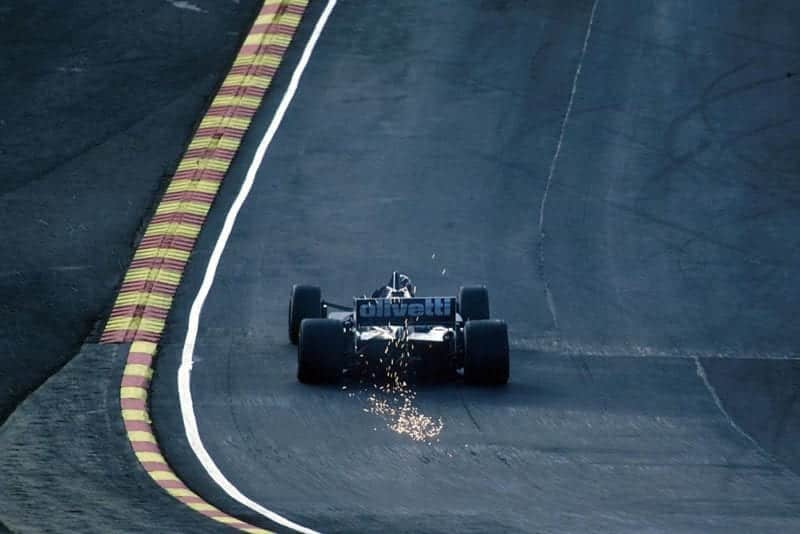
Nelson Piquet’s Brabham sparks through Paddock Hill
Motorsport Images
The sight of Alboreto and Johansson with their Ferraris down in 15th and 13th places, respectively, did not bear thinking about. It has become very hard for Maranello to admit that they are losing out on horsepower to Honda, BMW, Porsche and Renault, for Mr Ferrari has always maintained that his engines are the best, though history has never confirmed that statement. They are the best when the opposition is poor, but when serious engine people get down to it the Prancing Horse is invariably seen to be a Prancing Pony! When you have a surfeit of power over your rivals you can exploit aerodynamic drag to create down-force for cornering purposes, but when you are lacking in power you have to ease back on the down-force game in the hope of keeping up. The Ferraris were trying to keep up with the opposition by reducing drag but this found them wanting on handling, so they were in trouble on two scores. They weren’t lacking driver ability, like some teams. As far as Renault are concerned it would be unfair to say they have given up, with the end in sight after the Australian GP, but it certainly looks as though they have.
In spite of unsettled weather over most of the Country, the gods seemed to be smiling on Brands Hatch, in recognition of Mr Webb’s handling of the FISA/FOCA deals he had been dealt, and dry but cool weather had attracted an enormous crowd for the practice days and an even bigger one for race day. The Kentish Circuit was well and truly packed, and the usual day-long scene of activity on the ground and in the air was laid on for the paying public. There was racing for almost every category you could think of, including historic racing cars, in which there was an unfortunate fatality when Stephen Langton was thrown from his B-type Connaught and was run over by a following Competitor. Within the day-long activity two hours were put aside for a Formula One race, given the grandiose title of The Grand Prix of Europe, but in reality it was just another event in the 16 race programme to decide who would be 1985 World Champion.
Race
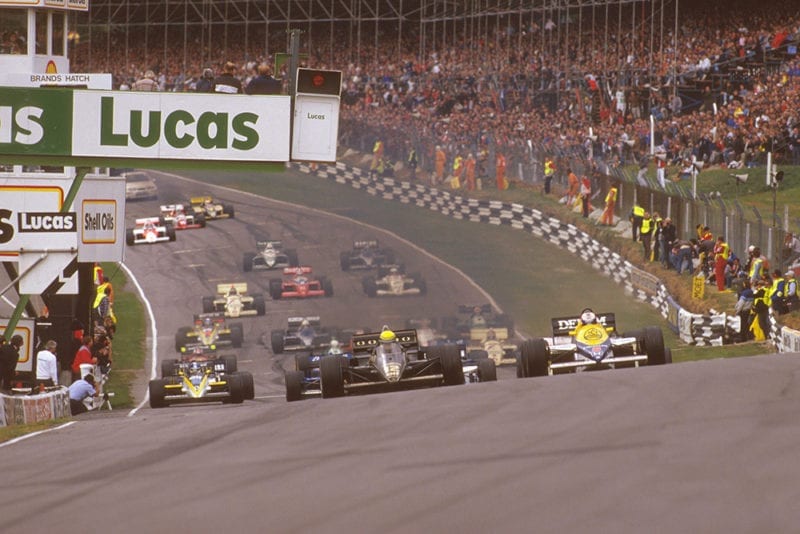
The field races towards the first corner at the start
Motorsport Images
The Sunday morning warm-up period gave all the signs that Pirelli had got a very competitive tyre for their users, and top of the list was Nelson Piquet’s Brabham-BMW, and as he was in second place on the grid things looked good for the Brazilian’s fan club. In the time that the cars were allowed a lap or two before lining up on the dummy-grid Warwick’s Renault was misfiring badly, and there was some dickering about as to whether he should swap to the T-car. However, the decision was made for them when the pit-lane exit was closed, so he had to resign himself to starting the race in a car that wasn’t running properly.
With the first two places on the grid occupied by Brazilian drivers you can make of that what you will, but behind them were the two Honda-powered Williams cars, and that was significant. When the cars lined up again after the parade-lap Piquet did not move up to his marker line, and by rights the start should have been aborted, but the green light was given at which Mansell did a really storming getaway to get up level with Senna’s Lotus which was not hanging about. Rosberg’s Honda engine fluffed slightly and, thinking it was going to stall, Prost jinked sideways from behind it, taking to the grass with the idea of going round the Williams. At that point the Japanese engine came on full song and Rosberg just disappeared, leaving Prost on the grass with no reason to be there!
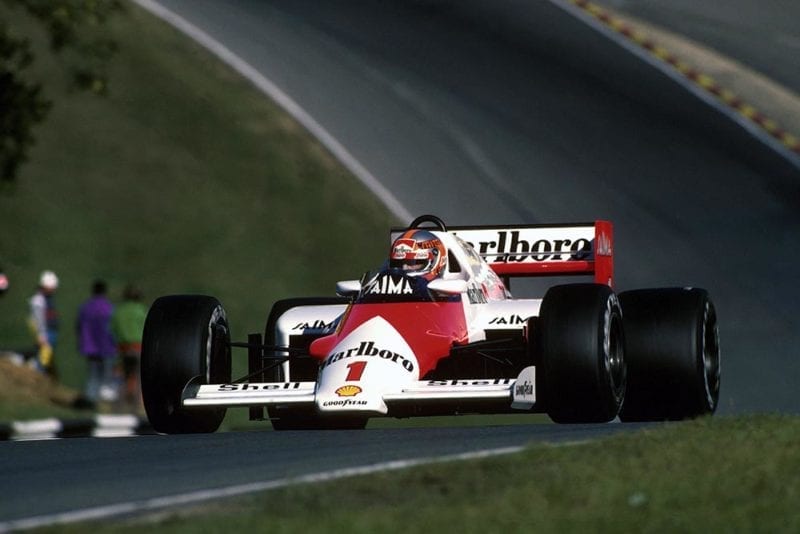
John Watson finished 7th on his return to grand prix racing
Motorsport Images
At the front Mansell was being very brave in trying to run round the outside of Senna’s Lotus as they plunged down Paddock Hill, but Senna was on a line across to the outside of the corner so Mansell had no option but to back off. Senna actually used the run-off area at the exit of the bend and went up the hill to Druids on the left, with Mansell right behind him. The incredible Rosberg had shot past Piquet and stormed up the hill on the right, diving into the hairpin behind Senna while poor old Mansell got elbowed off line and put two wheels on the grass on the outside of the corner, which let Piquet through into third place.
Within half a lap these four were pulling away into a race of their own, while behind them de Angelis was leading the rest of the field, all jumbled up into a “crocodile”. From his position down at the back of the grid Alan Jones had made a very aggressive start and passed a whole bunch of cars before he reached the timing line, and Derek Warwick had done a similar start, but to no avail as his engine was running terribly badly. He was to retire from the race before the dust of the opening lap had settled.

Although Senna was leading he was very conscious of the fact that the Honda-powered Williams were more than a match for his Renault power, and Rosberg was making it very obvious that he’d like to get by, especially as Piquet was right behind him and the combination of Piquet/Brabham/BMW and Pirelli looked to be well set for victory. For once there wasn’t a McLaren-Porsche in the picture, for Prost was driving carefully down in mid-field and Watson’s McLaren was almost last. As the leaders went along the Bottom Straight aiming for the climbing left-hander that would take them out into the country on lap seven, Rosberg made a desperate plunge up the inside of the leading Lotus. There was a brief “nudge” and then the Williams was into a graceful 180-degree spin, leaving Senna to go on his way.
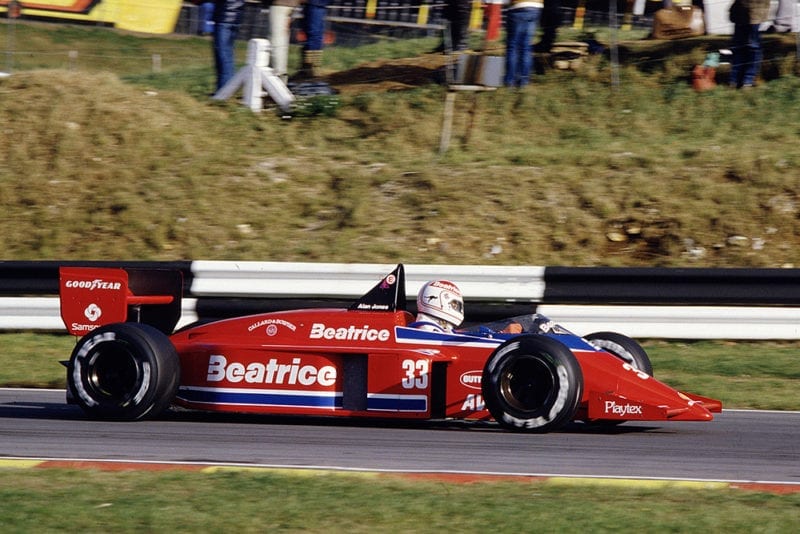
Alan Jones’s difficult Team Haas tenure continued – he retired with radiator problems on lap 13
Motorsport Images
The Williams rolled backwards across the track right into the path of Piquet’s Brabham and the left front wheel of the Brabham struck the left rear of the Williams. With the front wheels pointing different ways, and the nose fins off, Piquet’s car stopped in the middle of the track as Mansell went by on the inside, and then Rosberg did a 180-degree turn, using the grass verge and continued on his way, with a flat left rear tyre, going into the pits at the end of the lap for new rubber.
Piquet had no option but to sit tight in his derelict car until everyone had gone by, and then to return to the pits on foot with some rude things to say about Rosberg, while marshals dragged the stricken car off the track. As “Rock Ape” Rosberg rejoined the race Senna was hurtling along from Clearways, with Mansell charging along behind him. Senna caught Rosberg as they headed for Druids, and had to follow the Williams round the corner and down the hill, which allowed Mansell to close right up. On the Bottom Straight Rosberg was not really into his stride and was baulking Senna, but before the Lotus driver could decide to try and go to the left, the hard-charging Mansell zapped through on the inside, into a yellow flag no-passing zone caused by the retrieval of Piquet’s derelict Brabham, and the two Williams-Honda cars led the Lotus up the hill. Rosberg soon let his team-mate go by and then magnanimously decided to “help” him by blocking Senna round the back of the circuit. It was a very pretty, and unusual, bit of “team-driving” which we don’t see very often in these selfish days. Mansell made the most of it and was gone, and Senna settled for second place, knowing that he had not got the performance to catch a Honda even without any obstructions.
As far as the lead was concerned, that was it. The race was now Mansell’s and all he had to do was concentrate on not making a mistake or damaging his car or blowing up the engine. Not much to ask, except that only nine of the 75 laps had been run and for the next hour and a quarter he concentrated so hard that he was completely drained by the finish. He didn’t make any mistakes, he didn’t damage the car and he didn’t blow the engine up, but it was no easy afternoon drive, for he has been in this situation before and thrown it away.
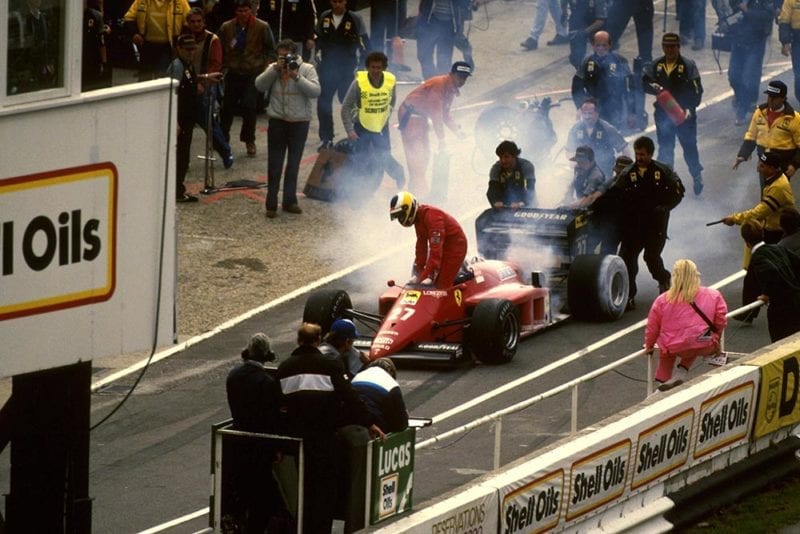
Michele Alboreto’s race went up in smoke on lap 13
Motorsport Images
For the rest of the runners there was some first class racing going on. Laffite was finding his Ligier going splendidly and his Pirelli tyres working really well, and Surer was in the same situation with his Brabham. Consequently these two made the most of it and became instant heroes, which everyone enjoyed seeing as two more sympathetic drivers would be hard to find. “Jack Lafferty” had a real chuckle to himself as he passed the future World Champion Alain Prost, and his all-conquering McLaren, and Marc Surer out-drove de Angelis and got by on the fast Hawthorn Bend, which put him into third place behind Mansell and Senna. Having dealt with Prost’s McLaren, Laffite tackled Johansson’s Ferrari and dealt with him in the same way, moving into fourth place. He didn’t have to deal with Alboreto’s Ferrari as the dejected Italian had gone into the pits at the end of lap 11 for a change of tyres, in the forlorn hope that they might make his car feel better. Two laps later a turbocharger failed and set the back of the car on fire, but “Albert” drove it back to the pits with a most impressive bonfire going on behind him, standing on the seat for the last few yards, ready to step out and leave the fire-marshals to put out the conflagration.
As half distance approached we saw the remarkable sight of first Surer passing Senna, and then Laffite going by; confirmation that there wasn’t much wrong with the Pirelli tyres, nor the two drivers. One could not help wondering where Piquet would have been if Rosberg had not put him out, for with all due respects to Surer’s ability, if he could get into second place, Piquet would have been a long way ahead. At half-distance the order was Mansell, well out on his own and looking very confident for a change, then Surer and Laffite, followed by Senna, de Angelis, Johansson, Prost, Brundle, Streiff and Rosberg, the fiery Finn really having a go following his contretemps, but then I have never seen Rosberg not having a go, regardless of where he is. There were only eight other cars still circulating, these being Boutsen’s Arrows, Patrese and Cheever in their Alfa Romeos, Watson in the second McLaren, Berger’s Arrows, Tambay’s Renault, Capelli’s Tyrrell and Danner in the Zakspeed. The rest had fallen by the wayside, some like Martini with a sickening thud as he hit the barriers, others like Alan Jones quietly with overheating troubles.
Prost now came in for a tyre change, it taking the McLaren team a long 16.9 Seconds as the right-front wheel baulked, but once back on the track with no-one in front of him Prost showed that he could still drive by reeling off a series of fastest laps. From lap 40 his lap times were as follows: 1.12.5; 1.12.4; 1.12.2; 1.13.1 (as he got baulked); 1.11.8; 1.11.6; the hall-mark of a master-driver, even if he had been driving like an old woman up to this point, intent on claiming the minimum number of points to become World Champion, with Alboreto retired, rather than trying to be a race winner.
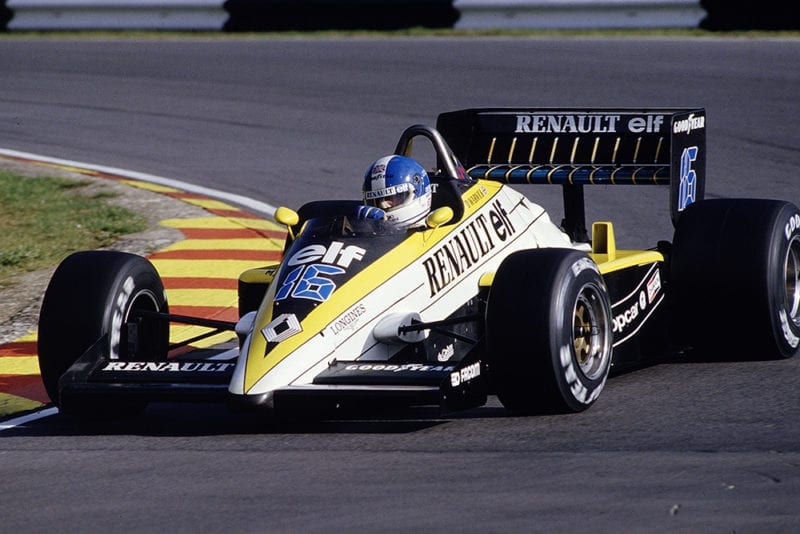
Renault’s Derek Warwick went out on lap 4 with fuel injection issues
Motorsport Images
This progress by Prost continued until he came up behind Patrese’s Alfa Romeo, whereupon his lap times dropped by three seconds while he followed the Italian at a discreet distance. Meanwhile Rosberg had been driving hard, but not as fast as Prost had been going, but the relaxation by Prost allowed the Williams driver to catch up and go by Prost, Patrese, and Boutsen and Streiff who were ahead of the Alfa Romeo. Brundle retired at the pits with a lot of smoke rising from the back of his Tyrrell, and Laffite stopped for another set of tyres, only to suffer engine failure a few laps later, which meant that Prost was promoted from seventh place to fourth aided by a pretty manoeuvre at Paddock Hill Bend when he got up behind de Angelis as they came up to lap Watson. In the sort of manoeuvre that you and I do at 20 mph in traffic, where you neatly box your rival in behind a slower car, Prost did just that at 120 mph or more, leaving de Angelis behind Watson as he powered down the hill into fifth place, which became fourth as Johansson went into the pits with a lack of electricity in his Ferrari.
With the end in sight Mansell kept going by sheer will power and determination, so much so that he was completely flaked-out at the finish. Not surprisingly he was getting terrific support from the partisan crowd, who were all willing him on to the finish. Surer’s fine race had finished in a cloud of smoke and flame from the engine compartment as the BMW turbocharger failed coming down the hill from Druids, and this let Senna back into a distant second place, followed by the ever charging Rosberg in third place, with Prost the only other driver on the same lap as the leader.
Thus it finished with heroes all, round. Nigel Mansell at last won a Grand Prix, after trying for so long and letting a number of likely victories slip through his fingers. This time he had a firm grip on the situation and nobody denied him his glory for he had really deserved it. Senna was simple and frank about the situation as always, there was nothing he could do about the combination of Mansell/Williams/Honda. He was glad to have made it into second place. Prost had done exactly what he set out to do, without taking any risks, and had made himself World Champion, even though there are two more races to be run. “Rock Ape” Rosberg in third place was one of those things that cannot happen. You can’t have an accident, do a slow lap on a flat tyre, make a pit stop, and finish third while others are racing all the time; or perhaps they aren’t racing, but merely going through the motions. Rosberg races all the time. Moments of glory for Surer and Laffite and a great shame that they had little to show for it, though “Happy Jacques” did get fastest lap.
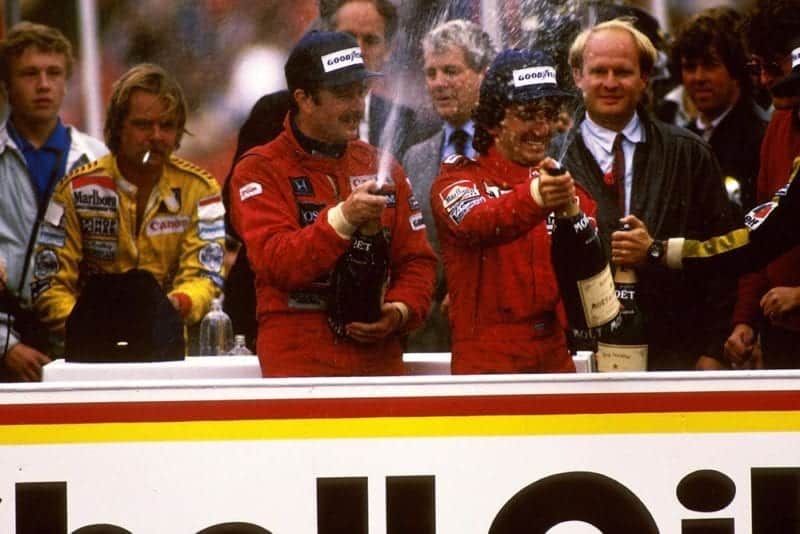
Mansell and Prost (right) celebrate on the podium whilst Rosberg does his usual warm-down routine in the background
Motorsport Images
A pity that the race was not called the Grand Prix of Kent, with HRH The Duke of Kent as patron of the race, for it would then have been a right royal occasion for Mansell to wave the Union Jack to show that British drivers can win Grand Prix races, even if they don’t do it very often. – D.S.J.
Results
Grand Prix of Europe – Formula One – 75 laps – Brands Hatch – 4.206 Kms per lap – 315.511 kms – Dry and cool
1st: Nigel Mansell (Williams FW10B/6) 1 hr 32 min 58.109 sec – 203.625 kph (126.527 mph)
2nd: Ayrton Senna (Lotus 97T/4) 1 hr 33min 19.505 sec
3rd: Keijo Rosberg (Williams FW10B/7) 1 hr 33 min 56.642 sec
4th: Alain Prost (McLaren MP4/2B-2) 1 hr 34 min 04.230 sec
5th: Elio de Angelis (Lotus 97T/3) 1 lap behind
6th: Thierry Boutsen (Arrows A8/4) 2 laps behind
Fastest Lap: Jacques Laffite (Ligier JS25/05) on lap 55 in 1 min 11.526 sec — 211.734 kph (131.566 mph)
